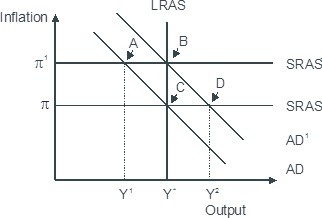Based on the figure below. Starting from long-run equilibrium at point C, an increase in government spending that increases aggregate demand from AD to AD1 will lead to a short-run equilibrium at point ________ creating _____gap. 
A. D; an expansionary
B. B; no output
C. B; expansionary
D. A; a recessionary
Answer: A
You might also like to view...
Refer to Figure 10.3. A decrease in the real interest rate, with no other changes that affect aggregate expenditure, is best represented by ________ in panel (a) and ________ in panel (b)
A) a shift from AE3 to AE2; a shift from IS2 to IS1 B) a shift from AE2 to AE3; a shift from IS1 to IS2 C) a shift from AE1 to AE2; a movement from point A to point B D) a shift from AE1 to AE3; a movement from point A to point C
When a person does not have to pay the full costs for using a scarce resource, then there is
A) an underproduction of a good. B) a negative externality. C) a positive externality. D) too little economic profit in the activity.
Pessimistic consumer expectations and decreased government spending are both associated with:
a. a downward movement along the aggregate demand curve. b. an upward movement along the aggregate demand curve. c. a leftward shift of the aggregate demand curve. d. a rightward shift of the aggregate demand curve. e. a steeper slope of the aggregate demand curve.
In responding to the Phillips curve hypothesis, Friedman argued that the Fed can peg the
a. unemployment rate. b. inflation rate. c. growth rate of real national income. d. All of the above are correct.